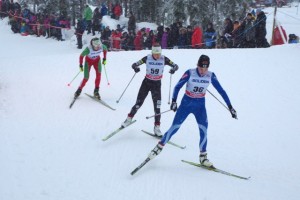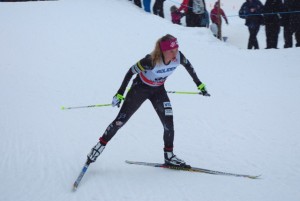
GÄLLIVARE, Sweden – A few kilometers into the 10 k freestyle race at Hellner Stadium today, something was happening that would have been unthinkable even just a year ago: four American women were skiing in the top ten.
Sure, it was at the 2.3 kilometer mark, but still. By five kilometers, there were still three in the top ten, and the fourth was only out of it due to a fall. Another American crashed on the second lap, but by the time results were final, it was still one of the best days in the history of the U.S. program: one athlete third (Kikkan Randall), another fifth (Holly Brooks), a third scoring points.
Liz Stephen and Jessie Diggins were left frustrated by their falls, both of which came on the technical course’s rutted corners, but remained confident after finishing 21st and 32nd. They know what might have been.
“It was going really well, I was getting good splits,” Diggins told FasterSkier at the finish line. “You know what, that happens, that’s racing. It was a really good experience, a good first race… with Holly and Kikkan, that is sooooo sweet, and if Liz also hadn’t fallen she would have been right up there, I know it. So I think it was a great day.”
Only Norway had a better team performance than the U.S., putting four skiers in the top eight. In the postrace press conference, third-place finisher Kikkan Randall took the opportunity talk about how things have changed for the Americans in the last five years. The 2012 Sprint Cup winner gets plenty of attention herself, but today she used her success as a microphone to warn the ski world to watch out for her teammates – something she didn’t even have before.

“We’ve been working really hard in the U.S. to build a women’s team,” she explained to the press. “When I first came to Gällivare, I was the only woman on the U.S. team. It was lonely. So I’ve been working on building a team, and now we have a team and we train together and have lots of fun. The relays are some of our big goals this year, so we’re really looking forward to tomorrow.”
Brooks placed fifth, and was hardly able to either contain herself or explain how it happened (for more from Brooks and Randall on their races specifically, see our main article). After spending 25 minutes in the winner’s chair, she was pushed out by Randall – and the ultra-competitive APU racer wouldn’t have it any other way.
“If anyone’s going to bump me out, I definitely want it to be her,” Brooks said. “The camera was panning over to me, and I was just pointing at the USA logo on my hat. Maybe early preparation for the relay tomorrow – tagging off with the podium chair instead of something else.”
That was a theme today: look out for the relays. The Americans, who had a fifth-place relay finish last season without Randall, might be even more dangerous because Stephen and Diggins are out for redemption.
“I’m looking forward to tomorrow for the relay and to get the chance to ski those corners again,” Stephen told FasterSkier.
According to Randall, the training group that the Americans now maintain throughout the year is what has made the biggest difference in their results. And clearly, not even the team themselves knew how fast they were; after training at home, isolated from the Europeans, they once again expected to arrive on the World Cup and be lagging slightly behind the Scandinavians, as has been the case year after year after year. Too often, flying to Europe meant getting your butt kicked.
“We’re away from the World Cup level for six months of the year,” Randall said. “You’re training with yourself, so you never see those incremental improvements. So we just keep focusing on what you need to do, and then you show up on the World Cup expecting, okay, I’m going to build my way into this.”

Although the U.S. women had great results last season, they only expected that again – not the level of depth they seemed capable of today. Except for one camp with the Swedish team they had no measuring stick all summer, so while they felt faster, the women really had no way of knowing how they’d stack up.
“Every year we’re just getting stronger, so it’s cool to be able to show up now, not feel like everything has gone perfectly, and still put down good performances,” Randall said. “We think that we’re at a certain place, and we’re actually ahead of where we think we are. It’s great to see, and it always helps when your teammates ski fast too. I can say for sure that we haven’t done anything special to be fast right now, so it bodes really well for the whole season.”
Looking at the big picture isn’t always easy; Diggins was clearly upset when she talked about her crash. But she also didn’t seem to regret her attitude going into today’s race. At 21 years old, she’s entering just her second World Cup season, and seemed able to take the experience as a lesson – not to be less aggressive, but rather to deal with the consequences when things don’t go as planned.
“I thought, well, why not just go big or go home, and instead I ended up in a ditch,” she said. “Right before the hill over the bridge there’s a really sharp righthand corner and I skidded out and I feel and went a little bit off. After that it was hard to get in the groove because I knew I had lost a lot of time. But this Finnish girl passed me and I was trying to just hang with her, thinking, ‘Get back into it, you don’t know what happened to everyone else, try to stay positive.’ It was a little test of focus for sure.”
Regardless of where they finished, the American women were caught up in a wave of excitement, finally understanding what kind of performances they are capable of.
“@kikkanimal 3rd and @brooksha1 5th! So proud of my teammates today! And happy with a solid distance skate race for me!” Ida Sargent tweeted after the race, where she placed 53rd.

And the contagious good spirit spread across the border north to Canada, where Chandra Crawford was pleased with the results sheet despite finishing 71st herself.
“Don’t write anything about me,” she told FasterSkier after the race. “How about Kikkan! And Holly! Incredible! My friends are amazing. My very dear friends are very fast, and I am so happy for them.”
Besides being North American neighbors who speak English and have a penchant for transatlantic air travel, the U.S. and Canadian women have forged a close bond over the last two or three years, creating what they have named the North American Women’s Training Alliance. Besides the growing depth of the U.S. program, Randall cited NAWTA as a big boost to her and her teammates.
“It’s just making it incredibly fun, and challenging,” she said. “We’re finding ways to push each other, getting together periodically for our camps, coming over here to Sweden for training… it’s great to show up to practice every day and know that you have to bring your “A” game.”
“NAWTA is a fast machine,” 2006 Olympic gold medalist Crawford agreed. “Those girls are so amazing. Kikkan has been doing such tough injury training these last months, so I think it just shows the mental fortitude and physical capacities of the Kikkanimal. You can’t mess with that.”
There’s a lot of synergy happening for the U.S. right now; several of the women cited the fan support here in Sweden as contributing to their strong performances. Stephen and Randall in particular have been close friends with Swedish star Anna Haag for several years, and this summer the entire American squad traveled here for a joint training camp.
“An advantage is that the Swedish fans are behind us now,” Stephen explained. “I’ve been over here two summers now, and the entire team was over here this summer. The Swedes are great. We were getting tons of cheers out there, more than in other countries. So Sweden feels a little more like home to me.”
And finally, even when she has a bad day, this is the best kind of bad day to have.
“Like Jessie said, as a team we’ve had a great day,” Stephen concluded. “It’s cool to come in and have one teammate there [in the leader’s chair], and then shortly behind you there’s another teammate that takes the chair. So it’s fun to just see these yellow coats everywhere, honestly.”
Chelsea Little
Chelsea Little is FasterSkier's Editor-At-Large. A former racer at Ford Sayre, Dartmouth College and the Craftsbury Green Racing Project, she is a PhD candidate in aquatic ecology in the @Altermatt_lab at Eawag, the Swiss Federal Institute of Aquatic Science and Technology in Zurich, Switzerland. You can follow her on twitter @ChelskiLittle.



